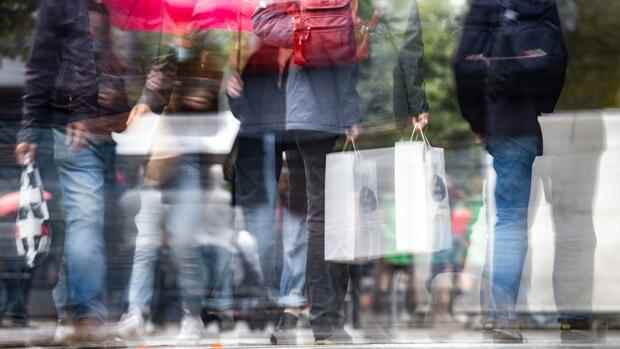Citizens’ income expectations have risen significantly recently.
(Photo: dpa)
Dusseldorf The list of bad news is long: The Ifo business climate has been down for four months, global delivery bottlenecks are leading to short-time working in industry and possibly empty shelves during the Christmas business, energy prices are exploding and driving inflation to ever new highs – some economists expect this the chip crisis, material shortage and the skyrocketing number of corona infections merely stagnated in the final quarter.
One ray of hope is consumer hunger for consumption, which has already generated decent growth in the third quarter. According to the Federal Statistical Office, the economy in the summer, when the economy grew by a strong 1.8 percent, “was primarily supported by higher private consumer spending”. The authority will only announce the details in four weeks.
For November, the HDE consumption barometer is signaling a better mood among consumers again. The index climbed 0.17 to 98.18 points. The HDE consumption barometer is calculated monthly by the Handelsblatt Research Institute for the HDE trade association. It is based on a representative consumer survey. Various components are included in the index according to their importance.
The prospect of a minimum wage makes one confident
Consumers’ income expectations rose noticeably, possibly also because the future traffic light coalition partners agreed on a rapid and significant increase in the minimum wage. The propensity to buy also increased significantly. On the other hand, consumers were concerned about the rising prices. For October, the Federal Statistical Office had determined an inflation rate of 4.5 percent – the highest value in 28 years. The inflation rate could possibly rise to five percent by the end of the year.
Top jobs of the day
Find the best jobs now and
be notified by email.
For the coming year, economists expect inflation to gradually decline; then, of course, prices will by no means fall, but only rise more slowly. One-off effects such as the price capers caused by the temporary VAT cut in the second half of 2020 will then expire.
However, the skyrocketing energy prices are likely to gradually be reflected in the end-user prices of numerous products via higher transport and manufacturing costs. In addition, the desired decarbonization is likely to gradually make many products more expensive.
The most important stabilizer of the economy in Germany is the labor market. In October seasonally adjusted unemployment fell by 39,000 people. Before the pandemic broke out, four-digit monthly changes were common.
Since the peak in June 2020, unemployment has fallen by around 460,000. “The consequences of the corona crisis on the labor market are still visible, but are getting smaller,” said the head of the Federal Employment Agency, Detlef Scheele, on Thursday. “Unemployment and underemployment are falling sharply, employment and business demand for new staff are increasing, and short-time working continues to decline.”
Obviously, in large parts of the economy there is great concern about the shortage of skilled workers. After all, employment will probably peak in two years’ time. Starting in 2026, around 130,000 people will retire of working age each year. This already makes it easier for unions and employees to implement wage increases – which could unleash the wage-price spiral feared by monetary politicians. Concerns about stagflation like during the oil crises in the 1970s are back.
More: “The hut is on fire”: DIHK lowers growth forecast – shortage of skilled workers slows the economy.

